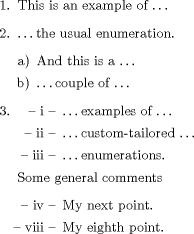在latex中有三種條列式方法 itemize 、 enumerate 、 discription很常被使用。
本文討論主題有:行距設定, 編號設定, 以及全文設定方式
- 排版之後, 每一條列項之前會有一文字或符號標籤(label)。在itemize 與enumerate 指令環境下,
條列項之標籤有內定之符號,但也可以自行設定。description 指令環境之標籤則由使用者自行輸入。
- 每個條列項底下可以再放一層,最多可放六層。
(1) 行距設定-項目與項目間的距離 :
在begin{itemize}使用\itemsep 調整 -1pt即縮小1pt,1pt則增加1pt.
(2) 調整enumerate數字清單的編號
參考文件: The enumerate package documentation
 預設的第一層是阿拉拍數字, 第二層是(a),(b),(c)
預設的第一層是阿拉拍數字, 第二層是(a),(b),(c)
\documentclass{article}
\usepackage{enumerate}
\begin{document}
\begin{enumerate}
\item This is an example of \ldots
\item \ldots the usual enumeration.
\begin{enumerate}[a)]
\item And this is a \ldots
\item \ldots couple of \ldots
\end{enumerate}
\item
\begin{enumerate}[-- i --]
\item \ldots examples of \ldots
\item \ldots custom-tailored \ldots
\item \ldots enumerations.
\newcounter{enumii_saved}
\setcounter{enumii_saved}{\value{enumii}}
\end{enumerate}
Some general comments
\begin{enumerate}[-- i --]
\setcounter{enumii}{\value{enumii_saved}}
如果要換另一個條列式項目, 但編號接續, 使用\newcounter{enumii_saved}來操作
\item My next point. \setcounter{enumii}{7}
使用setcounter{enumii}{數字}來指定編號號碼
\item My eighth point.
\end{enumerate}
\end{enumerate}
\end{document}
(3) enumerate也可以在全文指令環境中調整預設值: 層、標籤格式
表示條列的層:\labelitemi 與 \labelitemii
前者代表最外層之item指令環境;後者代表次一層之指令環境。再下一層之指令則為\labelitemiii..
此一指令環境之標籤是以阿拉伯數字或英文字母依序標出,控制指令有: \arabic, \roman, \Roman,與\Alph。譬如,
\renewcommand{\labelenumi}{\arabic{enumi})}
將把指令環境最外層之標籤改變成1), 2), . . .之形式。同理,下列指令則把標籤變成大寫羅馬字: I., II., . . . 。
\renewcommand{\labelenumi}{\Roman{enumi}}
(4) 設定每一層列舉條文的內縮距離
第一層列舉項之內 縮距離是以\leftmargini 控制,
最後的字母i 代表第一層; 第二層列舉項則以\leftmarginii 控制
用法
在\begin{itemize}之前 先下兩行,表示第一層內縮7mm,第2層縮6mm
\leftmargini=7mm
\leftmarginii=6mm
[转] http://www.cnblogs.com/dearjustine/archive/2010/04/05/1704508.html
-------------------------------
LaTeX/列表
枚举、列举和描述
\begin{list_type}
\item The first item
\item The second item
\item The third etc \ldots
\end{list_type}
默认的 list_type 有 enumerate、 itemize 和 description,区别主要是列项标签的不同。enumerate 是有序的列表;itemize 用圆点;description 需要 \item[label] 指定标签。各种列表环境可以互相嵌套,此时,enuemrate 的标签会自动变化以体现分级层次。
如果不想让列项第一行和标签同行,加一个 \hfill。
\begin{description}
\item[First] \hfill \\
The first item
\item[Second] \hfill \\
The second item
\item[Third] \hfill \\
The third etc \ldots
\end{description}
紧凑的列表
以上的列表环境空白较大,如果需要更紧凑的列表方式,可以选用 mdwlist 宏包提供的 itemize*、enumerate* 和 description* 环境,用法和无星号的版本一致。
定制列表环境
距离
在列表的内部,很容易改变一些距离
\begin{itemize}
\setlength{\itemsep}{1pt}
\setlength{\parskip}{0pt}
\setlength{\parsep}{0pt}
\item first item
\item second item
\end{itemize}
更详细的参数需要看下面 list 环境。
标签和计数器
枚举的列表计数可以通过其计数器来改变。enumerate 提供了四个计数器 enumi,enumii,enumiii, enumiv 对应不同层次的枚举。
\begin{enumerate}
\setcounter{enumi}{4}
\item fifth element
\end{enumerate}
会产生
5. fifth element
LaTeX 可以用其他格式打印这些计数器的值,
| 命令 | 例子 |
|---|---|
| \arabic | 1, 2, 3 ... |
| \alph | a, b, c ... |
| \Alph | A, B, C ... |
| \roman | i, ii, iii ... |
| \Roman | I, II, III ... |
| \fnsymbol | 星号,单剑号,双剑号等 |
% 重定义第一级计数显示
\renewcommand{\theenumi}{\Roman{enumi}}
\renewcommand{\labelenumi}{\theenumi}
% 重定义第二级计数显示
\renewcommand{\theenumii}{\Alph{enumii}}
\renewcommand{\labelenumii}{(\theenumii)}
这样看起来有些麻烦。有时候直接写
\renewcommand{\labelenumi}{\Roman{enumi}}
但是这样有一个缺点:如果在列表内部引用这些计数器,就会按原来的格式打印。
对列举 itemize 而言,无须计数。标签的形式可以通过 \item[label] 来改变。或者通过各级 \labelitemi,\labelitemii,\labelitemiii,\labelitemiv。所以
\item[$\star$]
等价于
\renewcommand{\labelitemi}{$\star$}
enumerate 宏包
enumerate 宏包为 enumerate 提供了更灵活的标签。可以使用 A,a,I,i,1 作为可选项产生 \Alph,\alph,\Roman,\roman,\arabic 的效果。
usepackage{enumerate}
......
\begin{enumerate}[(i)]
\item The first item
\item The second item
\item The third etc \ldots
\end{enumerate}
行内列表
paralist 宏包提供了 inparaenum 环境,产生不分段的列表。同样支持跟上面 enumerate 宏包类似的格式化标签。
\usepackage{paralist}
......
\textbf{\itshape Inline lists}, which are sequential in nature, just like enumerated lists, but are
\begin{inparaenum}[\itshape a\upshape)]
\item formatted within their paragraph;
\item usually labelled with letters; and
\item usually have the final item prefixed with `and' or `or',
\end{inparaenum} like this example.
list 环境
最有可定制性的当属 list 环境。以上的 enumerate, itemize,description 其本质上都是封装好的 list 环境。
\begin{list}{label}{spacing}
\item First item
\item Second item
\end{list}
其中, label 的内容将会作为标签,放在一个单独的盒子里,出现在每一 item 之前。也可以通过 \item[label] 来实现。
spacing 设定一些距离。通常为空,因为默认距离已经足够好了。
- \topsep 列表顶部与之前内容的额外空白,不含 \baselineskip
- \partopsep 如果列表之前是一个空行,列表顶部的额外空白
- \itemsep 列表各项之间额外的垂直空白
- \parsep 一个 item 中,如果分段,段落间额外空白
- \leftmargin 列表与左边距之间的水平距离,值为非负
- \rightmargin 列表与右边距之间的水平距离,值为非负
- \itemindent 每一 item 第一行的缩进
- \listparindent 每一 item 第一行之后各行的缩进
- \labelsep 标签盒子与每一 item 第一行文本之间距离
- \labelwidth 标签盒子的宽度;如果标签过长,这一宽度会自动变大,直到列表的第一行文本为止
- \makelabel{label} 生成 \item[label] 命令所要求的标签
- \usecounter{ctr} 使用列表项目计数器 ctr,初始值为 0
一个例子
% 定义计数器
\newcounter{Lcount}
% 标签计数显示为罗马数字
\begin{list}{Item-\Roman{Lcount}}
% 使用计数器
{\usecounter{Lcount}
% 左右对称
\setlength{\rightmargin}{\leftmargin}}
% 开始
\item This is the first item
\item And this is the second item
\end{list}
效果将是
Item-I This is the first item Item-II And this is the second item